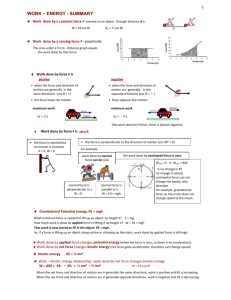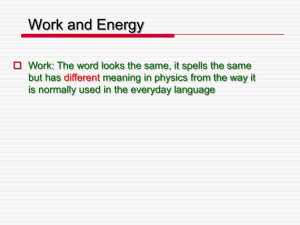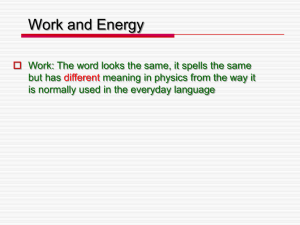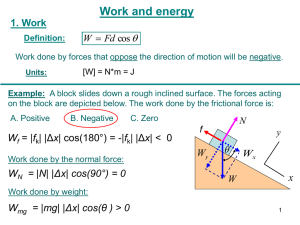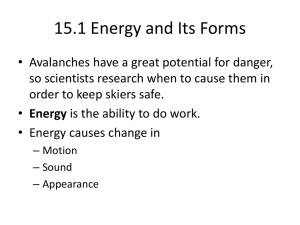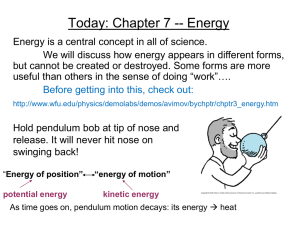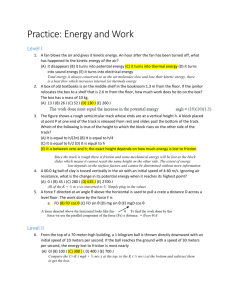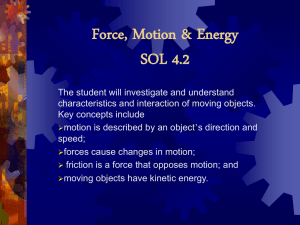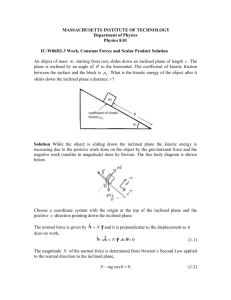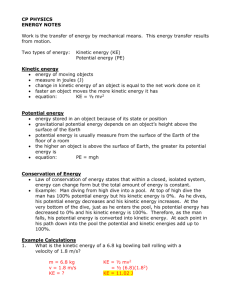Work and Energy - Uplift Education
advertisement
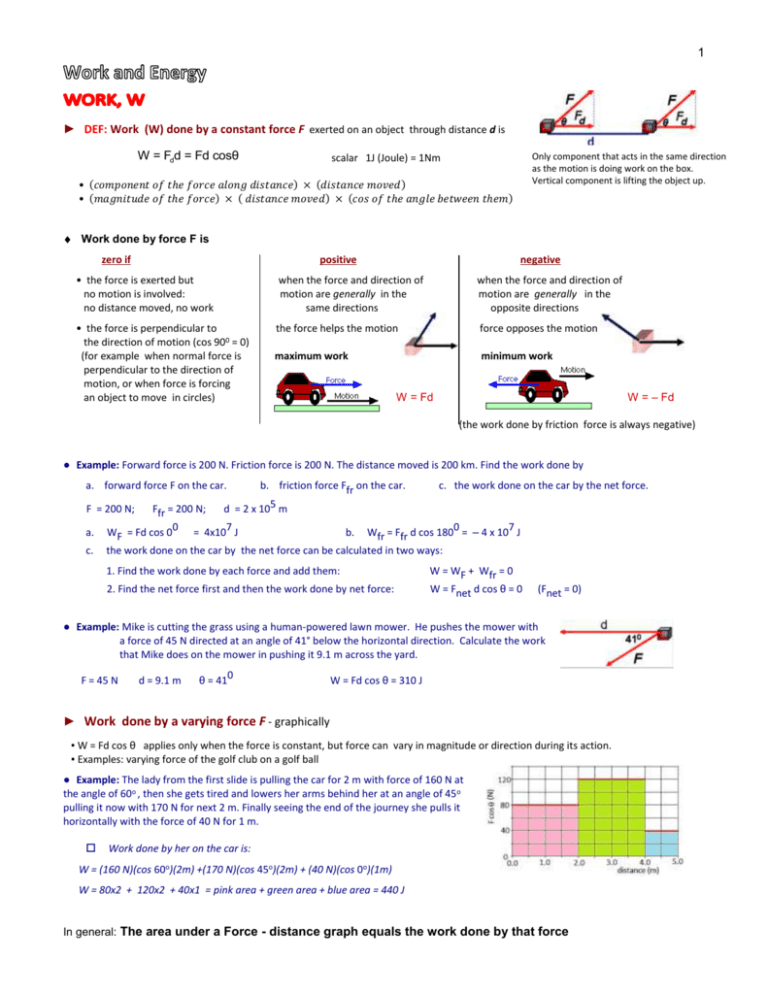
1 ► DEF: Work (W) done by a constant force F exerted on an object through distance d is W = Fdd = Fd cosθ Only component that acts in the same direction as the motion is doing work on the box. Vertical component is lifting the object up. scalar 1J (Joule) = 1Nm • (𝑐𝑜𝑚𝑝𝑜𝑛𝑒𝑛𝑡 𝑜𝑓 𝑡ℎ𝑒 𝑓𝑜𝑟𝑐𝑒 𝑎𝑙𝑜𝑛𝑔 𝑑𝑖𝑠𝑡𝑎𝑛𝑐𝑒) × (𝑑𝑖𝑠𝑡𝑎𝑛𝑐𝑒 𝑚𝑜𝑣𝑒𝑑) • (𝑚𝑎𝑔𝑛𝑖𝑡𝑢𝑑𝑒 𝑜𝑓 𝑡ℎ𝑒 𝑓𝑜𝑟𝑐𝑒) × ( 𝑑𝑖𝑠𝑡𝑎𝑛𝑐𝑒 𝑚𝑜𝑣𝑒𝑑) × (𝑐𝑜𝑠 𝑜𝑓 𝑡ℎ𝑒 𝑎𝑛𝑔𝑙𝑒 𝑏𝑒𝑡𝑤𝑒𝑒𝑛 𝑡ℎ𝑒𝑚) Work done by force F is zero if positive negative • the force is exerted but no motion is involved: no distance moved, no work when the force and direction of motion are generally in the same directions when the force and direction of motion are generally in the opposite directions • the force is perpendicular to the direction of motion (cos 900 = 0) (for example when normal force is perpendicular to the direction of motion, or when force is forcing an object to move in circles) the force helps the motion force opposes the motion maximum work minimum work W = – Fd W = Fd (the work done by friction force is always negative) ● Example: Forward force is 200 N. Friction force is 200 N. The distance moved is 200 km. Find the work done by a. forward force F on the car. b. friction force Ffr on the car. c. the work done on the car by the net force. Ffr = 200 N; d = 2 x 105 m WF = Fd cos 00 = 4x107 J b. Wfr = Ffr d cos 1800 = – 4 x 107 J the work done on the car by the net force can be calculated in two ways: F = 200 N; a. c. 1. Find the work done by each force and add them: 2. Find the net force first and then the work done by net force: W = WF + Wfr = 0 W = Fnet d cos θ = 0 (Fnet = 0) ● Example: Mike is cutting the grass using a human-powered lawn mower. He pushes the mower with a force of 45 N directed at an angle of 41° below the horizontal direction. Calculate the work that Mike does on the mower in pushing it 9.1 m across the yard. F = 45 N d = 9.1 m θ = 410 W = Fd cos θ = 310 J ► Work done by a varying force F - graphically ▪ W = Fd cos θ applies only when the force is constant, but force can vary in magnitude or direction during its action. ▪ Examples: varying force of the golf club on a golf ball ● Example: The lady from the first slide is pulling the car for 2 m with force of 160 N at the angle of 60o , then she gets tired and lowers her arms behind her at an angle of 45o pulling it now with 170 N for next 2 m. Finally seeing the end of the journey she pulls it horizontally with the force of 40 N for 1 m. Work done by her on the car is: W = (160 N)(cos 60o)(2m) +(170 N)(cos 45o)(2m) + (40 N)(cos 0o)(1m) W = 80x2 + 120x2 + 40x1 = pink area + green area + blue area = 440 J In general: The area under a Force - distance graph equals the work done by that force 2 In physics energy and work are very closely linked. If an object has energy it can do a work. On the other hand the work done on an object is converted into energy. ● Gravitational potential energy, PE = mg h Minimum force needed to lift up a mass m a vertical distance ∆h at constant speed is F = mg. Work done by applied force against gravitational force (when the net force is zero, so there is no acceleration) W = F h cos 00 = mg h is stored as gravitational potential energy of the object. PE depends on the reference frame in which it is measured, so we keep in mind some reference level, like desk, lower reservoir of water, ground,…. and potential energy can be calculated relative to different initial positions. It depends only on VERTICAL distance from the initial position, not on the path taken. A ramp can reduce the force – can make life easier The same work is done if the object is pulled along a ramp or vertically upward. ▪ minimum force needed to pull an object along a ramp is F2 = mg sinθ. the work done against gravitational force is: W = F2 d cos 00 = mg sinθ d = mg h is the same as before and is stored as PE of the object at height h above initial position. W = F2 d = F1 h = mgh ● Kinetic energy, KE = ½ m v2 A moving object possesses the capacity to do work. A moving hammer can be used to do work in driving a nail into a piece of wood. How much work a moving object is capable of doing? The kinetic energy of a body essentially tells us how much work the body is capable of doing. Imagine an object of mass m accelerated from rest by a resultant force, F. After traveling a distance d the mass has velocity v: The work done by net force is: W = Fd cos 00 = Fd = mad v2 = u2 + 2ad → ad = v2 /2 so work is W = ½ mv2 The work done (by the force F in moving the object a distance d is now expressed in terms of the properties of the body and its motion. The quantity ½ mv2 is called the kinetic energy (KE) of the body and is the energy that a body possesses by virtue of its motion. So, ◘ If the net force acting on an body is not zero, then: the change in the kinetic energy of the object is equal to the net work done on the object. W = ∆KE = KEf – KEi = ½ mv2 – ½ mu2 ● Work – Kinetic energy relationship ◘ KE depends on the reference frame in which it is measured. When you are sleeping, you have zero KE relative to your bed. ◘ But relative to the sun, you have KE = ½ (60 kg) (30000 m/s)2 ● Units W = Fd (W) = (1N)(1m) = 1 kg m2//s2 = 1 J PE = mgh (PE) = (1kg)(1m/s2 )(1m) = 1 kg m2//s2 = 1 J KE = ½ mv2 (KE) = (1kg)(1m/s)2 = 1 kg m2//s2 = 1 J Even in units we see that the work and energy are equivalent. ● Example: A father pushes his child on a sled on level ice, a distance 5 m from rest, giving a final speed of 2 m/s. If the mass of the child and sled is 30 kg, how much work did he do? What is the average force he exerted on the child? W = ∆ KE = ½ m v2 – 0 = ½ (30 kg)(2)2 = 60 J W = Fd = 60 J, and d = 5 m, so F = 60/5 = 12 N 3 ● Example: A 1000-kg car going at 45 km/h. The driver is on the cell phone not seeing a tree in front. Upon hitting the tree the car collapses one foot (o.3 m). How much work must this tree/friction force do in order to stop the car? What average force is required to stop a 1000-kg car going at 45 km/h if the car collapses one foot (0.3 m) upon impact? u = 45 km/h = 45 x 1000 m/3600 s = 12.5 m/s W = ∆ KE = 0 – ½ m u2 = – ½ (1000 kg) (12.5 m/s)2 = – 78125 J W = – 78 kJ (the negative sign just means the work leads to a decrease in KE) W= –Fd F = – W/d F = 78125 J/0.3 m = 260 x 103 N corresponds to 26 tons hitting you OUCH ◘ we shall see in nuclear physics that this should actually be the principle of mass-energy conservation ◘ To demonstrate the so-called principle of energy conservation we will solve a dynamics problem in two different ways, one using Newton’s laws and the kinematics equations and the other using the principle of energy conservation. ● Example: An object of mass 4.0 kg slides from rest without friction down an inclined plane. The plane makes an angle of 30° with the horizontal and the object starts from a vertical height of 0.5 m. Determine the speed of the object when it reaches the bottom of the plane. At point A: h = 0.5 m and KE = 0 (u = 0) At point B: h = 0 and the object has gained kinetic energy. Method 1: Newton’s law The force down the plane F = g sinθ m h v 2 = u2 +2ad = 0 + 2g sinθ sinθ F = mg sinθ v = 2gh a= v = 3.2 m/s Method 2: Conservation of energy As the object slides down the plane its potential energy becomes transformed into kinetic energy. If we assume that no energy is ‘lost ’ (converted into heat), we can write PEA = KEB mgh = ½ mv2 v = 2gh v = 3.2 m/s only vertical distance ● Conservation of energy law ◘ The second solution involves making the assumption that potential energy is transformed into kinetic energy only (no energy is converted into heat, sound….). ◘ This is ‘energy conservation principle’, this means the energy is conserved. Energy cannot be created or destroyed; it may be transformed from one form into another (for example from potential to kinetic energy), but the total amount of energy doesn’t change. ◘ If it is transformed into thermal energy, we say it is dissipated. The object can’t keep that energy. It is shared with environment. ◘ When using the energy principle we are only concerned with the initial and final conditions and not with what happens in between. ◘ No time included in energy principle. ◘ Very powerful tool of enormous importance. ◘ Clearly in this example it is much quicker to use the energy principle. 4 now problems and examples. Some of them would be very hard to solve using kinematic equations and Newton’s laws. ● Example: Amusement park physics ● Example: ◘ the roller coaster is an excellent example of the conversion of energy from one form into another ◘ work must first be done in lifting the cars to the top of the first hill. ◘ the work is stored as gravitational potential energy ◘ you are then on your way! PE is being transformed into KE and vice versa Dropping down from a pole. As he dives, PE becomes KE. Total energy is always constant equal to initial energy. If accounted for air resistance, then how would the numbers change? In presence of air, some energy gets transformed to heat (which is random motion of the air molecules). Total energy at any height would be PE + KE + heat, so at a given height, the KE would be less than in vacuum. What happens when he hits the ground? Just before he hits ground, he has large KE (large speed). This gets transformed into heat energy of his hands and the ground on impact, sound energy, and energy associated with deformation . ● Example: `● Example: A child of mass m is released from rest at the top of a water slide, at height h = 8.5 m above the bottom of the slide. Assuming that the slide is frictionless because of the water on it, find the child’s speed at the bottom of the slide. Three balls are thrown from the top of the cliff along paths A, B, and C with the same initial speed (air resistance is negligible). Which ball strikes the ground below with the greatest speed? a. A b. B c. C d. All strike with the same speed Do you think you could use Newton’s laws and get acceleration and velocity? Try it. Good luck ! Much easier: Law of conservation of energy: mgh = ½ mv2 m cancels on both sides The initial PE + KE of each ball is: mgh + ½ mu2 v = 2gh = 13 m/s This amount of energy becomes KE before impact: ½ mv2 mgh + ½ mu2 = ½ mv2 m cancels The speed of impact for each ball is the same v= 2gh + u2 . It depends ONLY on HEIGHT and initial SPEED, not the path taken, not mass, NOT PATHs !!!!! ◘ Work is a way of transferring energy from one form to another, but itself is not a form of energy. All types of energies and work have the same units. Everything can be transformed into each other. ◘ When work is done on an object, energy is transferred to that object. A baby, an elephant and you would reach the bottom at the same speed !!!!! And, by the way, it is the same speed as you were to fall straight down from the same height. v2 = u2 + 2gh = 2gh ● Example: v = 2gh = 13 m/s A spring at the bottom of a slide is compressed by an external force. A parent releases the spring when a child sits on it. EPE is transferred to the child by spring force doing the work which is transformed into KE of the child. On the way up KE is being transformed into PE. This energy is what enables that child to then do work. How? First that PE has to be transformed back into KE; child slides down a slide. KE of the child can do work on the waiting parent – it can knock him over. Surprise, surprise!!! The parent got everything back. Parent does the work on the ground. 5 ● Example: ● Example: A car (toy car – no engine) is at the top of a hill on a frictionless track. What must the car’s speed be at the top of the first hill if it can just make it to the top of the second hill A simple pendulum consists of a 2.0 kg mass attached to a string. It is released from rest at A as shown. Its speed at the lowest point B is: PEA + KEA = PEB + KEB PE1 + KE1 = PE2 + KE2 1 1 mv A2 + mghA = mvB2 + mghB 2 2 1 0 + ghA = mvB2 + 0 0 2 mgh1 + ½ mv12 = mgh2 + ½ mv22 m cancels out ; v2 = gh1 + ½ v12 = gh2 vB = 2ghA = 6m/s v1 = 2g(h2 -h1 = 22 m/s ● Conservation of energy law AGAIN – WITH FRICTION INCLUDED All previous examples were neglecting friction force, air resistance … What happens if the friction force acts? Can we still use conservation of energy principle? ● Example: An object of mass 4.0 kg slides 1.0 m down an inclined plane starting from rest. Determine the speed of the object when it reaches the bottom of the plane if a. friction is neglected a. all PE was transformed into KE initial energy = final energy b. constant friction force of 16 N acts on the object as it slides down. b. Friction converts part of kinetic energy of the object into heat energy. This energy equals to the work done by the friction. We say that the frictional force has dissipated energy. initial energy – Ffr d = final energy PEA = KEB PEA – Ffr d = KEB mgh = ½ mv2 mgh – Ffr d = ½ mv2 20 – 16 = 2.5 v2 v = 2gh = 3.2 m/s ● Power is the work done in unit time or energy converted in unit time (Wfr = – Ffr d) d = 1.0 m v = 1.4 m/s P= W t or P = E t measures how fast work is done or how quickly energy is converted. Power is a scalar quantity. Units: 1 W(Watt) = 1J(joule) 1s ● Example: A 100 W light bulb converts electrical energy to heat and light at the rate of 100 J every second. ◘ There is another way to calculate power P= W Fdcos00 d = =F t t t P = Fv Power is equal to force times velocity, providing that both force and velocity are constant and in the same direction. Constant velocity with a force applied ?????? That’s because we are interested in one force only. Net force is obviously zero. Like power of the engine of the car.
